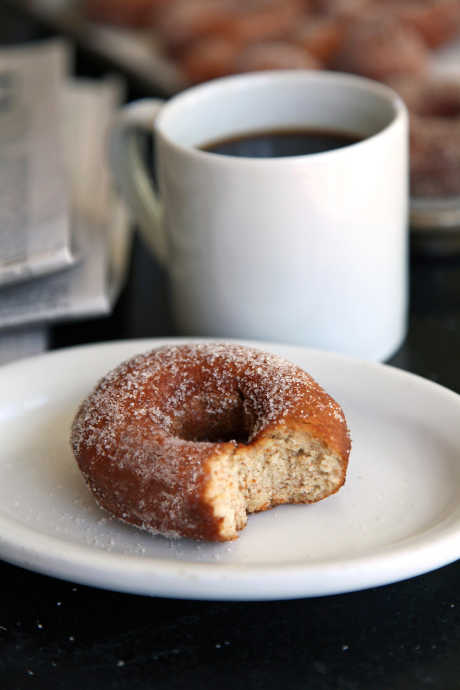Time to Make the Doughnuts
Posted by Julie on Jun 1st 2020
While it’s debatable whether doughnuts are a breakfast food or a dessert, what’s not debatable is how delicious they are. Whether you prefer cake doughnuts or yeast doughnuts, these sweet treats are a favorite any time of day. Sure, it’s convenient to grab a dozen from your local doughnut shop, but we’re all about broadening our culinary horizons. In this post, we’ll cover the differences between cake and yeast doughnuts, along with some recipes to try.
Cake vs. Yeast
Did you even know there are two major kinds of doughnuts? You may have noticed a difference in texture between a glazed or jelly doughnut, and a doughnut that’s loaded with frosting and toppings. That’s because the former is a yeast doughnut, and the latter is a cake doughnut.
Which came first, yeast doughnuts or cake doughnuts? Yeast doughnuts date back millennia. Bon Appetit reminds us that yeast doughnuts are essential fried bread dough, and the ancient Chinese and Romans did just that. We’ve written before about paczki, which are essentially Polish jelly doughnuts, and zeppole are a similar, well-known Italian pastry. Chowhound notes the yeast doughnuts we enjoy today come from the Dutch, who introduced their pastries to America. Because yeast occurs naturally, it’s been used as a leavener to make dough rise ever since people have been making dough.
Cake doughnuts, on the other hand, use chemical leaveners like baking soda and baking powder. According to Bon Appetit, cake doughnuts are an American creation.

The leaveners used in yeast and cake doughnuts are responsible for their respective textures. Chowhound describes yeast doughnuts as light and chewy. The gas bubbles produced by yeast create large air pockets inside yeast doughnuts. On the other hand, cake doughnuts are dense and crumbly. Baking soda and baking powder make them rise, though not as much as yeast doughnuts. That’s why they have a texture more like that of muffins (or cake). That’s also why cake doughnuts are superior for dunking.
The inside of a yeast doughnut isn’t as sweet as a cake doughnut, because it’s basically bread. Yeast doughnuts are covered in glaze, topped with frosting, rolled in powdered sugar, or filled with jelly or cream to give them the sweetness characteristic of doughnuts. Serious Eats notes this distinction may account for why some people prefer yeast doughnuts over cake doughnuts: If you have a sweet tooth, you’re more likely to opt for a cake doughnut.
Frying Doughnuts
Traditional doughnuts, whether they’re cake or yeast, are fried. You can bake doughnuts, and we’ll offer a recipe for baked doughnuts below, but the ones you buy at the doughnut shop are fried.
The same rules apply for frying doughnuts as they do for making tempura and churros. Fry in a heavy-bottomed pot that’s deep enough to contain the oil; Serious Eats recommends a Dutch oven. Use a neutral-flavored oil with a high smoke point. While there are all sorts of ways to gauge the temperature of your oil, we stand by our advice to use a cooking thermometer. Not only will this allow you to see whether the oil has returned to the proper frying temperature after each batch of doughnuts, it also helps you see if the oil has gotten too hot (which puts it at risk for catching fire).
Homemade Yeast Doughnuts
Let’s start with this recipe for yeast doughnuts from Food52. Remember that working with yeast means you’ll have to let the dough rise, which adds to the overall prep time. Use a stand mixer with a dough hook attachment to help speed up the active prep time, rather than kneading by hand.

We especially like this recipe because of all the variations included at the bottom. You can glaze your doughnuts with a simple mixture of powdered sugar and milk or cream, or you can add fruit puree, Meyer lemon juice, coconut milk, or cocoa powder to mix up the flavors. This approach allows you to create a variety of doughnuts even if you only make a dozen of them.
Homemade Cake Doughnuts
We found several plain cake doughnut recipes, but we decided to share this chocolate cake doughnut recipe from Serious Eats. One reason we love it, besides that it’s chocolate, is the minimal inactive prep time. The dough only rests for ten minutes before you roll and cut it. Keep the flour handy; you’ll want to flour your rolling surface and your cutters to keep the dough from sticking. Transfer your cut-outs to a floured tray before frying them.
While yeast doughnuts float, cake doughnuts sink initially. They are more dense than oil. As they cook, they’ll rise to the surface. Once they’re at the top, let them cook for about two minutes on each side. After they’ve cooled, you can glaze them according to this recipe. Or frost them and pile on the gourmet toppings, like crushed cookies and chocolate candies.
Homemade Apple Cider Doughnuts
Although apple cider doughnuts are a seasonal favorite in the fall, we couldn’t leave them out. We hope you’ll bookmark this recipe from Damn Delicious. Not only are these doughnuts smothered in cinnamon sugar, they also include apple cider that’s been reduced on the stovetop to concentrate the flavor. They’re cake doughnuts, but they do require a bit more inactive prep time than other cake doughnut recipes. The apple cider needs time to cool, and the dough should rest for an hour in the refrigerator before rolling and cutting. However, we’re confident they’ll be worth the wait.
 Free shipping over $49
Free shipping over $49










